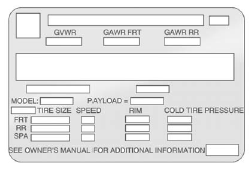 GMC Terrain: Certification Label
GMC Terrain: Certification Label

Label Example
A vehicle-specific Certification label is attached to the lower center pillar on the driver side of the vehicle or on the rear edge of the driver door. The label shows the size of the vehicle's original tires and the inflation pressures needed to obtain the gross weight capacity of the vehicle. This is called Gross Vehicle Weight Rating (GVWR). The GVWR includes the weight of the vehicle, all occupants, fuel, and cargo.
The Certification/Tire label also tells you the maximum weights for the front and rear axles, called Gross Axle Weight Rating (GAWR). To find out the actual loads on the front and rear axles, you need to go to a weigh station and weigh the vehicle. Your dealer can help you with this. Be sure to spread out the load equally on both sides of the center line.
Never exceed the GVWR for the vehicle, or the GAWR for either the front or rear axle.
If the vehicle is carrying a heavy load, it should be spread out. See “Steps for Determining Correct Load Limit” earlier in this section.
WARNING
Do not load the vehicle any heavier than the Gross Vehicle Weight Rating (GVWR), or either the maximum front or rear Gross Axle Weight Rating (GAWR). This can cause systems to break and change the way the vehicle handles. This could cause loss of control and a crash. Overloading can also shorten the life of the vehicle.
Your warranty does not cover parts or components that fail because of overloading.
The label will help you decide how much cargo and installed equipment your vehicle can carry.
Using heavier suspension components to get added durability might not change your weight ratings. Ask your dealer to help you load your vehicle the right way.
If you put things inside your vehicle – like suitcases, tools, packages, or anything else – they will go as fast as the vehicle goes. If you have to stop or turn quickly, or if there is a crash, they will keep going.
WARNING
Things inside the vehicle can strike and injure people in a sudden stop or turn, or in a crash.
○ Put things in the cargo area of the vehicle. In the cargo area, put them as far forward as possible. Try to spread the weight evenly.
○ Never stack heavier things, like suitcases, inside the vehicle so that some of them are above the tops of the seats.
○ Do not leave an unsecured child restraint in the vehicle.
○ Secure loose items in the vehicle.
○ Do not leave a seat folded down unless needed.
 Steps for Determining Correct Load Limit
Steps for Determining Correct Load Limit
1. Locate the statement “The combined weight of occupants and cargo should never
exceed XXX kg or XXX lbs” on your vehicle's placard.
2. Determine the combined weight of the driver and pass ...
See also:
Manual transmission operation (if equipped)
Using the clutch
Manual transmission vehicles have a starter interlock that prevents
cranking the engine unless the clutch pedal is fully pressed.
To start the vehicle:
1. Make sure the parkin ...
Important Vehicle Design Features To Know
WARNING: Your multipurpose vehicle
has handling characteristics that differ from those of a conventional passenger
car. For the safety of you and your passengers, please read the following sectio ...
Tunnel console
1 Storage compartment (for CDs, etc.) under
armrest, AUX input/USB connector.
2 Includes cup holder for driver and passenger,
12-volt socket and small storage compartment. ...

